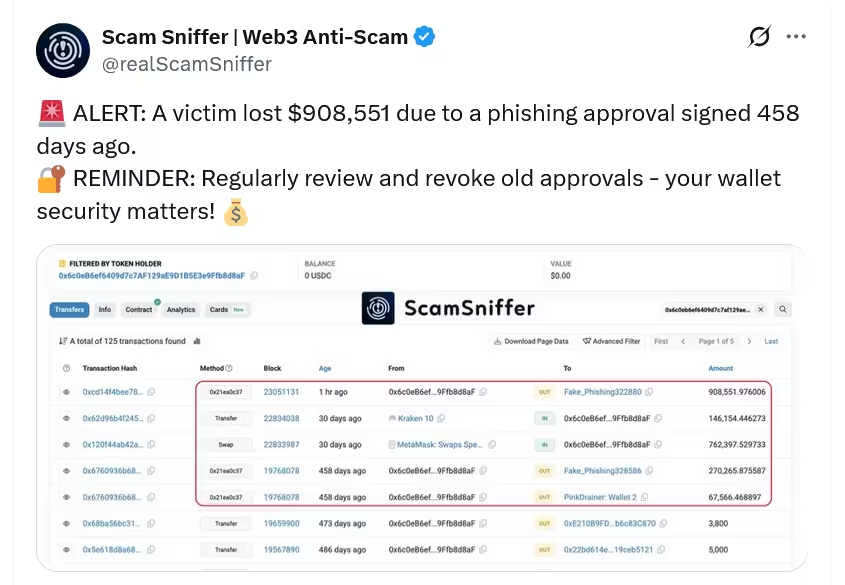4 Minutes
Phishing Scheme Drains Close to $1 Million from Crypto User
In a meticulously planned phishing attack, a cryptocurrency enthusiast lost $908,551 in digital assets after unknowingly signing a malicious transaction. What sets this incident apart is the hacker’s remarkable patience—waiting nearly 15 months before striking. The attacker monitored the victim's wallet, biding their time until significant funds accumulated before executing a sudden, calculated theft.
On-chain Data Reveals Attack Through ERC-20 Token Approval
According to blockchain analysis from Mihan Blockchain, the theft was enabled by an ERC-20 token approval transaction. Most likely, the victim approved this transaction via a deceptive phishing website or through a fake airdrop campaign. This approval provided the attacker’s wallet address, identified as 0x67E5Ae, with a permanent authorization to access the victim’s assets at any time.
The Malicious Transaction that Opened the Door
The culprit is linked to the notorious wallet “pink-drainer.eth.” At 8:27 AM on August 2, the hacker siphoned $908,551 worth of USDC stablecoin from the victim’s wallet in a single transaction. Notably, this occurred precisely 458 days after the initial harmful token approval was signed on April 30, 2024.
The scam was first reported by Scam Sniffer on X (formerly Twitter), which urged cryptocurrency users to regularly check and revoke old token approvals. Without these precautions, even a single click could jeopardize their entire wallet balance. As Scam Sniffer reminded: Secure your crypto wallet before it’s too late.

Strategic Patience: Waiting for the Right Moment
For more than a year, the compromised wallet was all but inactive, holding minimal funds and showing little transaction activity—giving the attacker no incentive to act. But the situation shifted dramatically on July 2, when the victim transferred a substantial $762,397 from their Metamask wallet to the vulnerable address 0x6c0eB6. A further $146,154 in USDC was transferred just ten minutes later from a wallet linked to the Kraken exchange.
The hacker kept a close watch over these large deposits, lying in wait for the optimum time to strike. On August 2, as the wallet’s balance peaked, the attacker executed a swift sweep, withdrawing the entire sum instantly.
This case illustrates a common characteristic of advanced crypto phishing attacks: hackers quietly wait, sometimes for months, until their target’s wallet balance justifies the risk and effort of theft.
How Crypto Users Can Protect Themselves from Phishing
Fortunately, there are effective ways for Ethereum users to safeguard their wallets from these types of attacks. The Token Approval Checker tool on Etherscan allows users to view and revoke unnecessary token approvals—a proactive step in reducing vulnerability. However, it’s important to note that each revocation incurs a small gas fee.
Industry reports show the extent of this problem, with over $142 million lost to at least 17 separate attacks in July alone. The largest incident involved the hacking of CoinDCX exchange, but individual wallet compromises like this one highlight the ongoing risks within the blockchain ecosystem.
Regularly managing token approvals, staying vigilant against phishing sites and fake airdrops, and following trusted security practices are crucial for anyone involved in the cryptocurrency space.
Source: cointelegraph


Leave a Comment